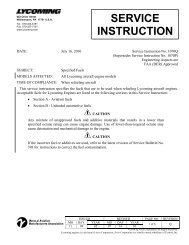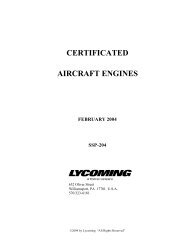Create successful ePaper yourself
Turn your PDF publications into a flip-book with our unique Google optimized e-Paper software.
GOOD VS. IRREGULAR MAINTENANCE<br />
Regular maintenance, performed by qualified personnel using<br />
factory-recommended inspection procedures and intervals, will<br />
contribute to engine performance and the capability of reaching the<br />
manufacturer recommended TBO hours. Stretching inspection or<br />
oil change intervals may create the illusion of saving money, but is<br />
really false economy. Regular oil changes and scheduled maintenance<br />
play an important role in achieving recommended TBO.<br />
FREQUENCY OF FLIGHT<br />
Frequency of flight also plays an important part in the operating<br />
history of an engine. Engines flown only occasionally and with<br />
extended periods between oil changes are subject to corrosion<br />
because of acids that build up in the oil and attack internal<br />
metallic parts of the engine. Only regular oil changes can eliminate<br />
these acids.<br />
Moisture that enters through the breather or exhaust system can<br />
cause rusting of cylinders and other steel parts. Rings may take<br />
a set and stick in the groove. Condensation in the magnetos may<br />
cause shorting of the breaker points. Flying as often as possible to<br />
bring the engine temperatures up to their normal operating levels<br />
will help to eliminate moisture. A ground run of the engine only<br />
is not considered satisfactory. Frequent flights are needed.<br />
The number of hours that need to be flown each month, and<br />
the length of time between flights cannot be specified for every<br />
aircraft and engine. Variables such as geographic location and<br />
local temperature and humidity must be considered. Inactivity<br />
and time will cause hardening of gaskets, seals and hoses. Long<br />
periods between flights can be expected to cause excessive wear<br />
during engine start due to loss of the protective oil film on bearing<br />
surfaces during the long periods of inactivity. Regardless of the<br />
operating hours, those engines that have not reached the recommended<br />
number of operating hours for TBO in a 12-year period<br />
must be overhauled or replaced during that twelfth year.<br />
DECISION TIME<br />
The timing of engine overhaul or replacement is sometimes the<br />
result of government regulations. Anytime regulations are not<br />
a factor, the engine owner must make the decision to overhaul<br />
or replace the engine based on knowledge of the engine and the<br />
conditions under which it has been operated. This decision may<br />
come before the engine has reached the recommended number of<br />
operating hours, or in some cases, after that number of operating<br />
hours has been achieved.<br />
TBO recommendations apply to the engine, and in some cases,<br />
engine accessories and propellers. There is the possibility that<br />
certain components such as magnetos, ignition harness, governors<br />
and other engine-driven accessories may require overhaul<br />
or replacement prior to engine overhaul. This decision, too, is to<br />
be made by the party responsible for maintaining the engine, or<br />
by the accessory manufacturer.<br />
NEW ENGINE<br />
A new engine is a product manufactured by <strong>Lycoming</strong><br />
containing all new parts and accessories, and meeting all<br />
production test specifications, quality control tests and regu-<br />
L y c o m i n g F l y e r<br />
lations necessary to hold and maintain a “production certificate”<br />
issued by the FAA. When this engine has met each of<br />
these criteria and is shipped to an airframe manufacturer, it<br />
will be subject to further testing during flight test of the aircraft<br />
for its certification acceptance. When the ultimate purchaser<br />
receives the aircraft, it may have also been subjected to ferry<br />
time. However, all flight testing and ferry time will be logged.<br />
The user then receives the engine with the full <strong>Lycoming</strong> new<br />
engine warranty, accompanied by an Engine Logbook.<br />
REBUILT ENGINE<br />
To the aircraft engine purchaser, the “rebuilt” engine, as provided<br />
by <strong>Lycoming</strong>, offers the opportunity to obtain many of the benefits<br />
of a new engine, but at a price savings.<br />
A <strong>Lycoming</strong> factory-rebuilt engine is defined as an aircraft engine<br />
originally designed and manufactured by <strong>Lycoming</strong> that has been<br />
disassembled, cleaned, inspected, repaired as necessary, reassembled,<br />
and tested to the same tolerances and limits as a new<br />
item, using either new parts or used parts that either conform to<br />
new part tolerances and limits or to approved oversized or undersized<br />
dimensions. Tolerances and limits established and published<br />
by <strong>Lycoming</strong>, and approved rework procedures, are used during<br />
the rebuilding of the engine so that the engine is brought back to<br />
zero time. It is important to note that the <strong>Lycoming</strong> factory is the<br />
only agency authorized by the FAA to return a <strong>Lycoming</strong> engine<br />
to ZERO time. Such engines retain their original serial number,<br />
but the letter “R” is added preceding the letter “L” on the data<br />
plate which designates rebuilt by <strong>Lycoming</strong>.<br />
Thus, a factory-rebuilt engine that has been returned to zero time,<br />
by <strong>Lycoming</strong>’s definition, has all the foregoing, plus the fact that<br />
it is done by <strong>Lycoming</strong> at its factory, by factory personnel with<br />
manufacturing and engineering expertise. This factory-rebuilt<br />
engine must also meet the same production test specifications<br />
used for a new engine. With each <strong>Lycoming</strong> factory-rebuilt<br />
engine, an Engine Logbook is furnished with <strong>Lycoming</strong> Form<br />
No. 489 included on the inside of the first page. Additionally, each<br />
engine released through the rebuilding system is accompanied by<br />
a maintenance release that refers to the factory order to which all<br />
work was performed.<br />
OVERHAULED ENGINE<br />
Overhaul is a term which certainly means different things<br />
to different people. When the aircraft owner has run a<br />
factory-new engine to TBO, and then paid for an overhaul,<br />
that owner usually has expectations of running the engine<br />
until the manufacturer’s recommended TBO has again been<br />
achieved. These expectations may or may not be realistic<br />
depending on what the overhauler puts into the overhaul. There<br />
is no specific definition of the term overhaul in the Code of<br />
Federal Regulations for Aeronautics and Space (FAR). FAR<br />
Part 43 states the following about Maintenance, Rebuilding<br />
and Alteration.<br />
a. Each person maintaining or altering, or performing<br />
preventive maintenance, shall use methods, techniques<br />
and practices acceptable to the Administrator. The tools,<br />
equipment and test apparatus necessary to assure com-







